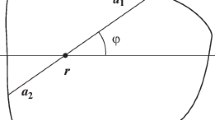Abstract
A novel approximate model is proposed for the evaluation of call blocking probabilities in mobile cellular networks with just one service class. The accuracy of the approximate model is assessed by comparison against results of detailed simulation experiments, a previously proposed model, and upper and lower bounds to the call blocking probability. Numerical results show that the proposed model is accurate, in spite of its remarkably small state space.
Similar content being viewed by others
Explore related subjects
Discover the latest articles, news and stories from top researchers in related subjects.References
M. Ajmone Marsan, G. De Carolis, E. Leonardi, R. Lo Cigno and M. Meo, How many cells should be considered to accurately predict the performance of cellular networks? in: European Wireless'99, Munich, Germany (October 1999).
R. Beraldi, S. Marano and C. Mastroianni, Performance of a reversible hierarchical cellular system, International Journal of Wireless Information Networks 4(1) (1997).
D. Hong and S. Rappaport, Traffic model and performance analysis for cellular mobile radio telephone systems with prioritized and non-prioritized handoff procedures, IEEE Transactions on Vehicular Technology 35(3) (1986) 77–92.
K.K. Leung, W.A. Massey and W. Whitt, Traffic models for wireless communication networks, IEEE Journal on Selected Areas in Communications 12(8) (1994) 1353–1364.
Y. Lin, Modeling techniques for large-scale PCS networks, IEEE Communication Magazine 35(2) (1997) 102–107.
P. Tran-Gia and M. Mandjes, Modeling of customer retrial phenomenon in cellular mobile networks, Journal on Selected Areas in Communications, Special Issue on Personal Communication – Services, Architecture and Performance Issues 15(8) (1997) 1406–1414.
Rights and permissions
About this article
Cite this article
Ajmone Marsan, M., De Carolis, G., Leonardi, E. et al. An approximate model for the computation of blocking probabilities in cellular networks with repeated calls. Telecommunication Systems 15, 53–62 (2000). https://doi.org/10.1023/A:1019170207186
Issue Date:
DOI: https://doi.org/10.1023/A:1019170207186




